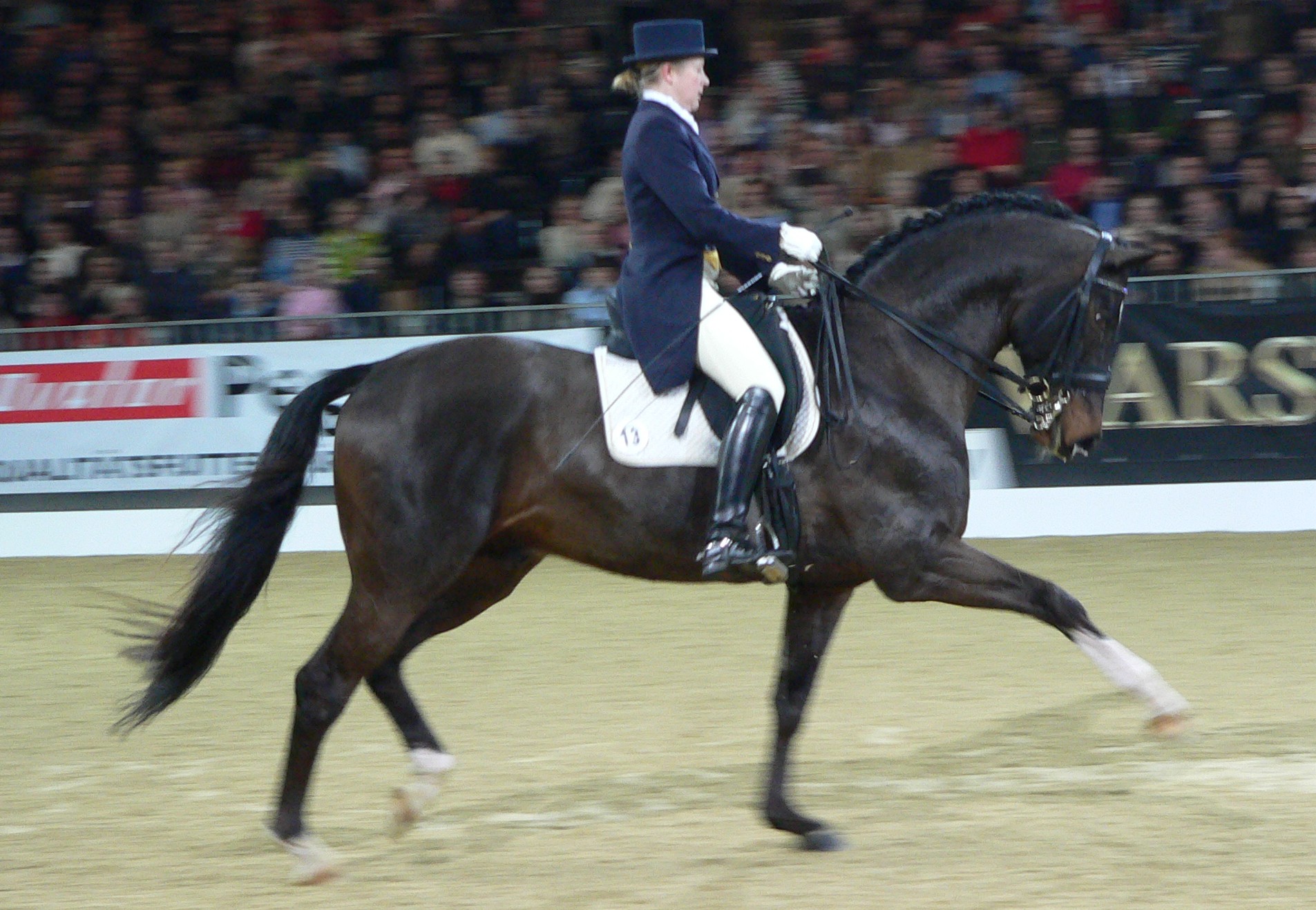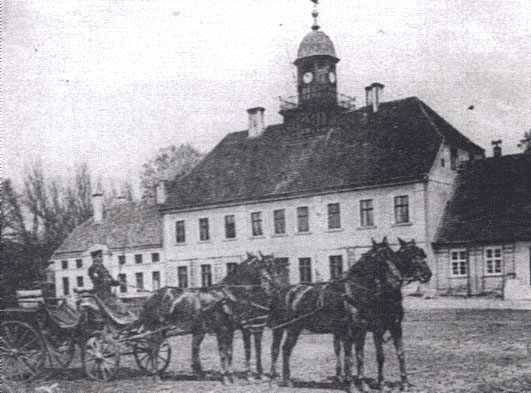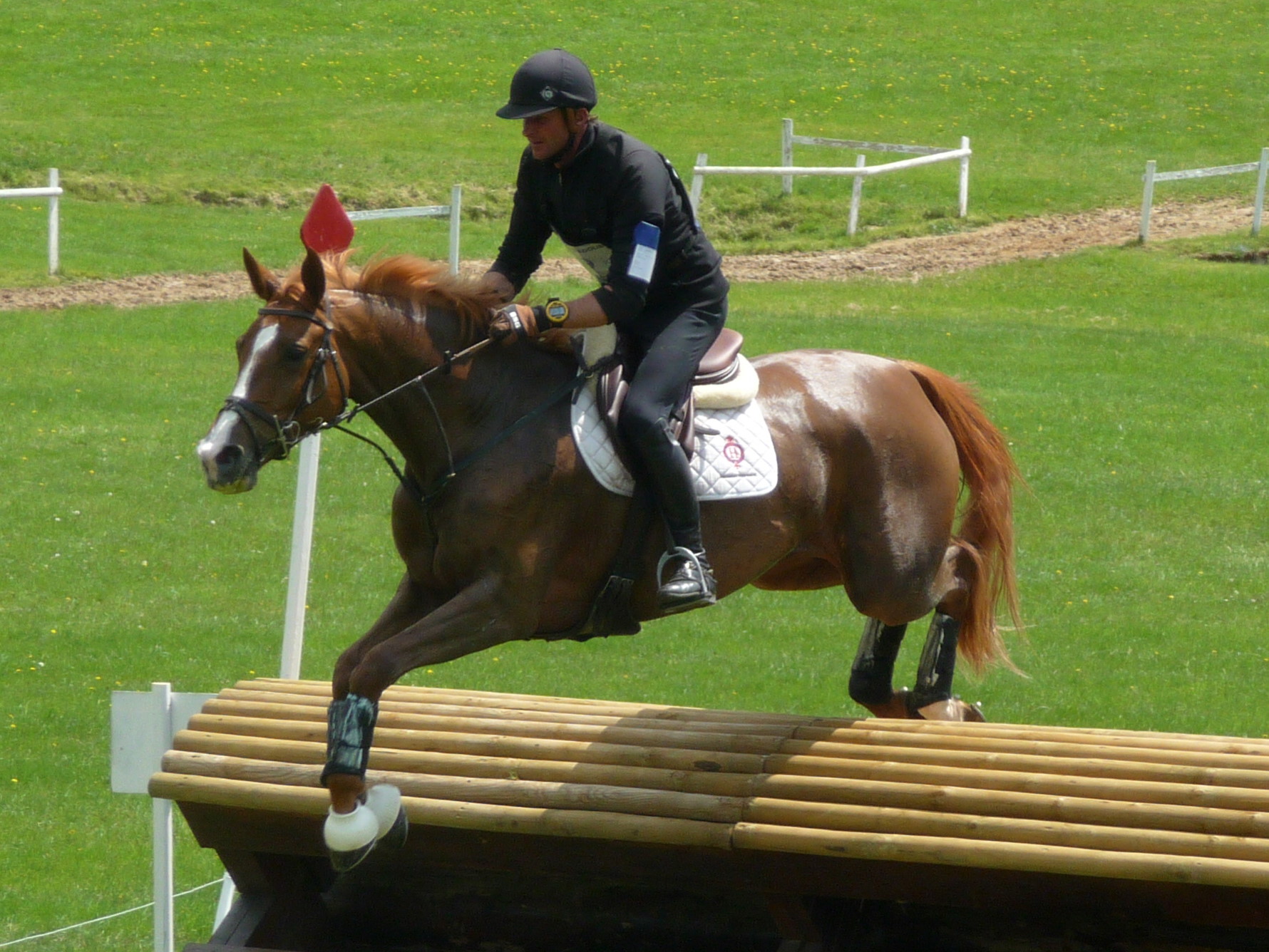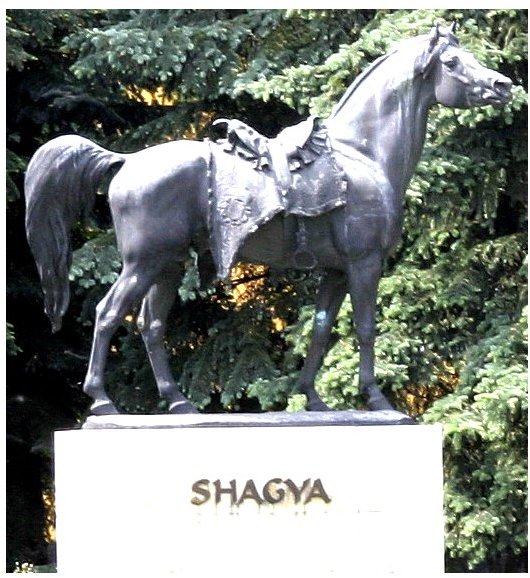|
Trakehner
Trakehner is a light warmblood breed of horse, originally developed at the East Prussian state stud farm in the town of Trakehnen from which the breed takes its name. The state stud ( :de:Hauptgestüt Trakehnen) was established in 1731 and operated until 1944, when the fighting of World War II led to the annexing of East Prussia by Russia, and the town containing the stud renamed as Yasnaya Polyana. The Trakehner typically stands between . They can be any color, with bay, gray, chestnut and black being the most common, though the breed also includes few roan and tobiano pinto horses. It is considered to be the lightest and most refined of the warmbloods, due to its closed stud book which allows entry of only Trakehner, as well as few selected Thoroughbred, Anglo-Arabian, Shagya and Arabian bloodlines. Characteristics Owing to its Thoroughbred ancestry, the Trakehner is of rectangular build, with a long sloping shoulder, good hindquarters, short cannons, and a medium-lon ... [...More Info...] [...Related Items...] OR: [Wikipedia] [Google] [Baidu] |
Trakehner Brand 0001
Trakehner is a light warmblood horse breed, breed of horse, originally developed at the East Prussian state stud farm in the town of Trakehnen from which the breed takes its name. The state stud (:de:Hauptgestüt Trakehnen) was established in 1731 and operated until 1944, when the fighting of World War II led to the annexing of East Prussia by Russia, and the town containing the stud renamed as Yasnaya Polyana, Kaliningrad Oblast, Yasnaya Polyana. The Trakehner typically stands between . They can be any color, with bay (horse), bay, gray (horse), gray, chestnut (coat), chestnut and black (horse), black being the most common, though the breed also includes few roan (horse), roan and tobiano pinto horses. It is considered to be the lightest and most refined of the warmbloods, due to its closed stud book which allows entry of only Trakehner, as well as few selected Thoroughbred, Anglo-Arabian, Shagya Arabian, Shagya and Arabian horse, Arabian bloodlines. Characteristics Owing ... [...More Info...] [...Related Items...] OR: [Wikipedia] [Google] [Baidu] |
Trakehner 2
Trakehner is a light warmblood breed of horse, originally developed at the East Prussian state stud farm in the town of Trakehnen from which the breed takes its name. The state stud ( :de:Hauptgestüt Trakehnen) was established in 1731 and operated until 1944, when the fighting of World War II led to the annexing of East Prussia by Russia, and the town containing the stud renamed as Yasnaya Polyana. The Trakehner typically stands between . They can be any color, with bay, gray, chestnut and black being the most common, though the breed also includes few roan and tobiano pinto horses. It is considered to be the lightest and most refined of the warmbloods, due to its closed stud book which allows entry of only Trakehner, as well as few selected Thoroughbred, Anglo-Arabian, Shagya and Arabian bloodlines. Characteristics Owing to its Thoroughbred ancestry, the Trakehner is of rectangular build, with a long sloping shoulder, good hindquarters, short cannons, and a medium-long, ... [...More Info...] [...Related Items...] OR: [Wikipedia] [Google] [Baidu] |
Trakehnen
Yasnaya Polyana (russian: Я́сная Поля́на; german: Trakehnen, from 1929 ''Groß Trakehnen''; lt, Trakėnai; pl, Trakeny) is a rural settlement (''posyolok'') in the Nesterovsky District of Kaliningrad Oblast, Russia. It is located in the southeast of the oblast, north of the Romincka Forest. Nearby Diwnoje Nowoje is a railway station on the former Prussian Eastern Railway from Kaliningrad to Kybartai in Lithuania. History The settlement was originally named after the Old Prussian word ''trakis'', meaning "great bog". It was known as ''Trakėnai'' in Lithuanian, ''Trakeny'' in Polish, and ''Trakehnen'' in German. In 1454, King Casimir IV Jagiellon incorporated the region to the Kingdom of Poland upon the request of the anti-Teutonic Prussian Confederation. After the subsequent Thirteen Years' War (1454–1466), it became a part of Poland as a fief held by the Teutonic Knights.Górski, pp. 96–97, 214–215 From the 18th century it formed part of the Kingdom ... [...More Info...] [...Related Items...] OR: [Wikipedia] [Google] [Baidu] |
Yasnaya Polyana, Kaliningrad Oblast
Yasnaya Polyana (russian: Я́сная Поля́на; german: Trakehnen, from 1929 ''Groß Trakehnen''; lt, Trakėnai; pl, Trakeny) is a rural settlement (''posyolok'') in the Nesterovsky District of Kaliningrad Oblast, Russia. It is located in the southeast of the oblast, north of the Romincka Forest. Nearby Diwnoje Nowoje is a railway station on the former Prussian Eastern Railway from Kaliningrad to Kybartai in Lithuania. History The settlement was originally named after the Old Prussian word ''trakis'', meaning "great bog". It was known as ''Trakėnai'' in Lithuanian, ''Trakeny'' in Polish, and ''Trakehnen'' in German. In 1454, King Casimir IV Jagiellon incorporated the region to the Kingdom of Poland upon the request of the anti-Teutonic Prussian Confederation. After the subsequent Thirteen Years' War (1454–1466), it became a part of Poland as a fief held by the Teutonic Knights.Górski, pp. 96–97, 214–215 From the 18th century it formed part of the Kingdo ... [...More Info...] [...Related Items...] OR: [Wikipedia] [Google] [Baidu] |
Arabian Horse
The Arabian or Arab horse ( ar, الحصان العربي , DIN 31635, DMG ''ḥiṣān ʿarabī'') is a horse breed, breed of horse that originated on the Arabian Peninsula. With a distinctive head shape and high tail carriage, the Arabian is one of the most easily recognizable horse breeds in the world. It is also one of the oldest breeds, with archaeological evidence of horses in the Middle East that resemble modern Arabians dating back 4,500 years. Throughout history, Arabian horses have spread around the world by both war and trade, used to improve other breeds by adding speed, refinement, endurance, and strong bone. Today, Arabian bloodlines are found in almost every modern breed of riding horse. The Arabian developed in a desert climate and was prized by the nomadic Bedouin people, often being brought inside the family tent for shelter and protection from theft. Selective breeding for traits, including an ability to form a cooperative relationship with humans, create ... [...More Info...] [...Related Items...] OR: [Wikipedia] [Google] [Baidu] |
Warmblood
Warmbloods are a group of middle-weight horse types and breeds primarily originating in Europe and registered with organizations that are characterized by open studbook policy, studbook selection, and the aim of breeding for equestrian sport. The term distinguishes these horses from both heavy draft horses ("cold bloods") and refined light saddle horses such as the Thoroughbred, Arabian, and Akhal-Teke ("hot bloods"). Although modern warmbloods are descended from heavier agricultural types systematically upgraded by hotblood influence, the term does not imply that warmbloods are direct crosses of "cold" and "hot". Breeding policies Open studbook policies separate most warmbloods from true "breeds" such as Thoroughbreds, Arabians, Percherons, and Morgans which have a closed stud book and require two purebred parents. Instead, most warmblood registries accept breeding stock from other similar populations to continuously improve their own, and do not consider their own horses ... [...More Info...] [...Related Items...] OR: [Wikipedia] [Google] [Baidu] |
Thoroughbred
The Thoroughbred is a horse breed best known for its use in horse racing. Although the word ''thoroughbred'' is sometimes used to refer to any breed of purebred horse, it technically refers only to the Thoroughbred breed. Thoroughbreds are considered " hot-blooded" horses that are known for their agility, speed, and spirit. The Thoroughbred, as it is known today, was developed in 17th- and 18th-century England, when native mares were crossbred with imported Oriental stallions of Arabian, Barb, and Turkoman breeding. All modern Thoroughbreds can trace their pedigrees to three stallions originally imported into England in the 17th and 18th centuries, and to a larger number of foundation mares of mostly English breeding. During the 18th and 19th centuries, the Thoroughbred breed spread throughout the world; they were imported into North America starting in 1730 and into Australia, Europe, Japan and South America during the 19th century. Millions of Thoroughbreds exist today, a ... [...More Info...] [...Related Items...] OR: [Wikipedia] [Google] [Baidu] |
Closed Stud Book
A breed registry, also known as a herdbook, studbook or register, in animal husbandry and the hobby of animal fancy, is an official list of animals within a specific breed whose parents are known. Animals are usually registered by their breeders while they are young. The terms studbook and register are also used to refer to lists of male animals "standing at stud", that is, those animals actively breeding, as opposed to every known specimen of that breed. Such registries usually issue certificates for each recorded animal, called a pedigree, pedigreed animal documentation, or most commonly, an animal's "papers". Registration papers may consist of a simple certificate or a listing of ancestors in the animal's background, sometimes with a chart showing the lineage. Types of registries There are breed registries and breed clubs for several species of animal, such as dogs, horses, cows and cats. The US ''Association of Zoos and Aquariums'' (AZA) also maintains stud books for captive ... [...More Info...] [...Related Items...] OR: [Wikipedia] [Google] [Baidu] |
Stud Farm
A stud farm or stud in animal husbandry is an establishment for selective breeding of livestock. The word "stud" comes from the Old English ''stod'' meaning "herd of horses, place where horses are kept for breeding". Historically, documentation of the breedings that occur on a stud farm leads to the development of a stud book. Male animals made available for breeding to outside female animals are said to be "standing at stud", or at "stud service", referencing the relatively high probability that they are kept at a stud farm. The word stud is often restricted to larger domesticated (especially farm) animals, such as cattle and horses. A specialized vocabulary exists for the studs of other animals, such as kennel (dog), cattery (cat) and aviary (birds). Horse stud farms Monastic stud farms During the Middle Ages, stud farms were often managed as part of a monastery. At the time, few people apart from monks could read and write, and so they were charged with the responsibility o ... [...More Info...] [...Related Items...] OR: [Wikipedia] [Google] [Baidu] |
Roan (horse)
Roan is a horse coat color pattern characterized by an even mixture of colored and white hairs on the body, while the head and " points"—lower legs, mane, and tail—are mostly solid-colored. Horses with roan coats have white hairs evenly intermingled throughout any other color. The head, legs, mane, and tail have fewer scattered white hairs or none at all. The roan pattern is dominantly inherited, and is found in many horse breeds. While the specific mutation responsible for roan has not been exactly identified, a DNA test can determine zygosity for roan in several breeds. True roan is always present at birth, though it may be hard to see until after the foal coat sheds out. The coat may lighten or darken from winter to summer, but unlike the gray coat color, which also begins with intermixed white and colored hairs, roans do not become progressively lighter in color as they age. The silvering effect of mixed white and colored hairs can create coats that look bluish or ... [...More Info...] [...Related Items...] OR: [Wikipedia] [Google] [Baidu] |
Anglo-Arabian
The Anglo-Arabian or Anglo-Arab is a crossbred, part-Arabian horse that now also has its own status as a horse breed. It is the result of a Thoroughbred (hence, the prefix "Anglo") being crossed with an Arabian. The cross can be made between a Thoroughbred stallion and an Arabian mare, or vice versa. It can also be a cross between either an Anglo-Arab and a Thoroughbred or, alternatively, an Anglo-Arab and an Arabian. Another permitted cross is between two Anglo-Arabians. No matter the cross, a horse must have a minimum 12.5% of Arabian blood to be considered an Anglo-Arabian. France is one of the greatest producers of Anglo-Arabians. The French Anglo-Arab traces back to two stallions: the Arabian stud Massoud and Aslam, a "Turkish" horse, probably of the now-extinct Turkoman or "Turkmene" breed. These Syrian imports were then crossed with a trio of Thoroughbreds, specifically, the Comus Mare, the Selim Mare, and Daer. Some years later, three of their daughters — Clovi ... [...More Info...] [...Related Items...] OR: [Wikipedia] [Google] [Baidu] |
Shagya Arabian
The Shagya Arabian is a horse breed which was developed in the Austro-Hungarian Empire during the 19th century at the Bábolna, Mezőhegyes, Radautz, Piber, and Topolcianky studs. Today it is most often seen in the Czech Republic, Austria, Romania, the former Yugoslavian countries, Poland, Germany, and Hungary, but has been exported to other nations and is bred around the world. A purebred Shagya Arabian today has bloodlines that can be traced in all lines to the stud books of Rădăuți, Babolna, and Topolcianky. The breed is considered by some to be a subtype of Arabian horse, but due to the presence of a small amount of non-Arabian breeding others consider it to be an Anglo-Arabian or a partbred Arabian. Origin One of the major founding sires was Shagya, a gray Arabian (or, some say part-Arabian) Stallion (horse), stallion with some ancestors of the Kehilan and Siglavy strains. Born in Syria in 1810, he was taller than the average Arabian of the time, standing ... [...More Info...] [...Related Items...] OR: [Wikipedia] [Google] [Baidu] |








